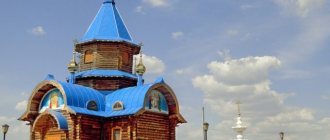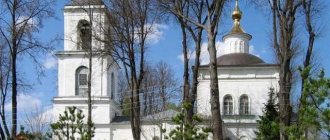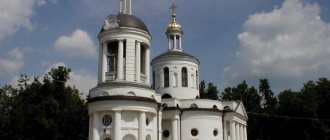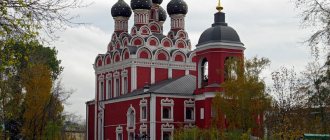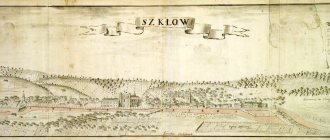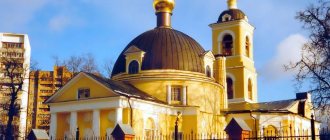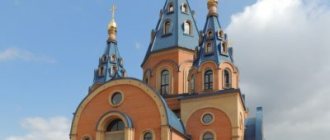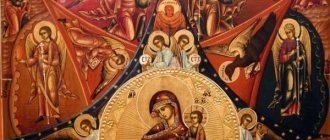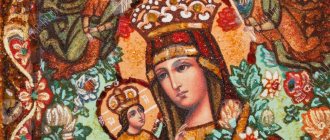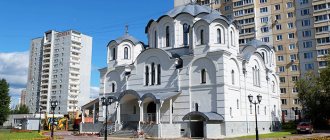"Save me, God!".
Thank you for visiting our website, before you start studying the information, please subscribe to our Orthodox community on Instagram, Lord, Save and Preserve † - https://www.instagram.com/spasi.gospodi/. The community has more than 60,000 subscribers. There are many of us like-minded people and we are growing quickly, we post prayers, sayings of saints, prayer requests, and timely post useful information about holidays and Orthodox events... Subscribe. Guardian Angel to you!
There are quite a large number of holy places and springs in Moscow. Throughout the centuries, huge numbers of pilgrims have flocked here to bow and offer prayers before the holy icons and relics of saints. Many churches and monasteries were built in honor of saints in Russia. One of these is the Life-Giving Spring Temple in Tsaritsyn.
A little about the construction of the shrine
As the name implies, the temple is consecrated in honor of the Life-Giving Spring. History says that in the 5th century, near Constantinople, there was a grove dedicated to the Virgin Mary. And there was a source that was considered miraculous. The Mother of God herself pointed out the location of this source to people.
Everyone who came to this source received healing from serious illnesses. In gratitude for the healing received, people first fenced the spring with a stone fence, and a little later they built a small church. It was sent to everyone who sincerely asked for help in healing.
The best article for you, go to: Temple of Faith, Hope and Love and their mother Sophia
This area did not get its name right away. Under Catherine II, Prince Golitsyn was the owner of the site where the church was built. In the years when there were Streltsy riots, it was taken away and it went to the treasury. It should be noted that the temple was originally built of wood, and it passed from one owner to another.
Of course, everyone rebuilt it a little and used it as a family tomb. And only when the site became the property of the Empress, the site was completely rebuilt. At that time, they changed its name to “Tsaritsyno”. Her summer residence was located on this territory.
Like many other churches, it was closed in 1939. After closing, a transformer booth was first placed in it, after which it housed a printing house and even a woodworking workshop. It is not surprising that the building could not withstand such tests and began to collapse a little. And only in the early 90s was the church in Tsaritsyn returned to Orthodox believers. In the same year, work began on its restoration.
Today the temple is open and fully functioning. In addition to holding services in the Tsaritsyno temple, there is a church library here, which contains a wide variety of rare books. It can be visited not only by those who study in Sunday school, but also by any interested parishioner.
The best article for you, go to: Church of the Assumption of the Blessed Virgin Mary in Veshnyaki
There is a Sunday school at the church. On its basis, a special group carries out its work, which is engaged in supporting individuals who, for one reason or another, are deprived of their freedom. The church is also known for its pilgrimage trips. She also provides free legal and psychological consultations.
Temple of the Icon of the Mother of God “Life-Giving Spring” in Tsaritsyno Park
The first church in Tsaritsino was built back in the 17th century. At first it was wooden, which quickly fell into disrepair and was rebuilt. It was made of stone from below with a wooden upper superstructure and dome. During the ownership of the Black Mud estate (the former name of Tsaritsyno) by the prince of the Moldavian family Cantemir, in response to his request, the Moscow Metropolitan allowed the construction of a new one, a brick one, on the site of the old church. The construction was carried out in the “Elizabethan Baroque” style, and white stone was used for the basement level and decoration. A bell tower of two tiers is attached to the main building. The church was consecrated in the summer of 1765.
In 1775, Catherine the Great became the owner of the Black Mud plot, which she renamed the village of Tsaritsyno. An imperial residence with a huge park is planned here. This was entrusted to the court architect Vasily Bazhenov, who decides to preserve the temple in a new architectural complex.
The War of 1812 left traces on all the buildings of Tsaritsino near Moscow, but the church building was especially damaged, which was smashed and looted by Napoleon’s army stationed here.
Since the 80s of the 19th century, an elite dacha community has emerged on the territory of the estate. The temple with the bell tower was restored and rebuilt. The refectory was expanded, the walls and vault were decorated with paintings and stucco, the floor was covered with slabs with marble chips, and a chapel with an altar was installed on the south side. Two more tiers of the bell tower were completed, the number of bells was increased to 6, and the largest of them weighed almost 3000 kg.
The October Revolution of 1917 did not make any adjustments to the service of the church. And this is despite the close proximity and activity of the “Political Sports Youth Union”, which is located on the premises of the Third Cavalry Corps. It is known that until 1934-38 the temple was in operation, and it was visited by the descendants of the Obolenskys and Sheremetevs, residents of the village of Lenino (formerly Tsaritsyno).
The temple lost its bells in 1934, and in 1938 it was completely closed. Local residents preserve the iconostasis, many icons are transferred to museums, some are saved by parishioners and clergy, but most, unfortunately, are destroyed.
The temple building changes its “owners” many times:
- in the 1940s it is used instead of a transformer point;
- a printing house has been operating here since 1972;
- Since 1975, a woodworking workshop belonging to the Soyuzrestavratsia association has been located inside.
Finally, in 1990, the building was returned to the believers and services were resumed. And in May 1998, the temple was re-consecrated by Patriarch Alexy II.
Service Schedule
A large number of parishioners visit the church every day. It preserves and stores such shrines as the ark with particles of the holy relics of Moscow Tikhon, St. M. Voronezh, St. Kiev-Pechersk and many others. Also here is the holy face of the icon of the Mother of God “Life-Giving Spring”.
Divine services in the Church of the Life-Giving Spring icon in Tsaritsyno are held daily:
- On weekdays, the reading of the Liturgies begins at 9:00 am and 17:00 pm.
- On weekends and holidays at 9:00 and 10:00 am, and evening at 17:00 pm.
In addition, the schedule of services at the Life-Giving Spring Church in Tsaritsyno includes the reading of the Liturgy with an akathist to the Mother of God every Sunday. Getting to the temple is not difficult. If you go by metro, then you need to get to the Orekhovo, Domodedovskaya, and Tsaritsyno metro stations. From them you need to walk for about 10 minutes. Buses No. 151, 203, 269, 679, 182, 756 also go to the church.
The best article for you, go to: Church of the Nativity of the Blessed Virgin Mary in Krylatskoye
The Lord is always with you!
Modern church building in the Tsaritsyno park-estate
When the estate was granted to the father of the famous Antioch Cantemir, a new stone church was erected on the site of the old church. However, the building turned out to be fragile, quickly sank and fell into disrepair.
In 1759 the temple was rebuilt.
The new monastery was crowned with an octagon with a small drum, decorated in the Baroque style. The decor of the temple on the outside is more restrained than on the inside. The church portals are high, with oval windows and volutes. The octagon is decorated with paired Tuscan pilasters.
In 1775, Catherine II decided to establish her residence in the village of Chernye Gryazi. She was really attracted to this picturesque place! Soon the place received the name Tsaritsino.
During the reconstruction of the estate, some construction work also affected the Theotokos Church.
In 1881-1883. a new bell tower of the “Life-Giving Spring” temple was erected in 3 tiers, the refectory was also expanded, while the general architectural style of the shrine was not disturbed.
Icon of the Mother of God “Life-Giving Spring”
Every year, on Friday of Bright Week, on the feast of the icon of the Mother of God “Life-Giving Source,” the brethren of the Danilov Monastery perform a service in Dolmatovo, in the courtyard of our holy monastery. Here is the revered image of the Blessed Virgin Mary. According to the charter, on this day, after the liturgy, an Easter religious procession is held from the church in honor of the Icon of the Mother of God “of the Sign” to the source for the small consecration of water. In all churches of the Russian Orthodox Church today, for the first time after the Great Hagiasma on Epiphany, a small consecration of water is being performed.
The appearance of this icon is associated with the miraculous event of the Mother of God healing a blind man. In the middle of the 5th century, outside the city wall of Constantinople, at the Silivrian Gate, there was a grove dedicated to the Blessed Virgin Mary. There was a spring in the grove, once famous for miracles, but gradually this place was overgrown with bushes, and the water was covered with mud. One day, the warrior Leo Marcellus, who later became emperor, met a blind traveler in a grove who had lost his way, who asked the warrior to give him water. Having seated the blind man in the shade under a tree, Leo went in search of the source. For a long time he could not find it, when suddenly he heard a voice that pointed him to the source and ordered him to put mud from its waters on the eyes of the blind man. When Leo fulfilled everything that was said, the blind man immediately received his sight and, without a guide, went to Constantinople, glorifying the Mother of God.
Having become emperor, Leo I Marcellus, who never forgot about this miracle, ordered the source to be cleaned and enclosed in a stone circle, over which a temple was built in honor of the Blessed Virgin Mary. Emperor Leo called this spring the “Life-Giving Spring,” since the miraculous grace of the Mother of God was manifested in it.
Another miracle occurred in the middle of the 6th century. Emperor Justinian the Great suffered from water sickness for a long time. One night he heard a voice: “You cannot regain your health unless you drink from My fountain.” The king did not know what source the voice was talking about, and became despondent. Then the Mother of God appeared to him in the afternoon and said: “Get up, king, go to My source, drink water from it and you will be healthy as before.” The patient fulfilled the will of the Lady and soon recovered. The grateful emperor erected a new magnificent temple near the temple built by Leo, at which a monastery was subsequently created.
After the fall of Constantinople in 1453, the temple was destroyed, and a Muslim guard was assigned to its ruins, who did not allow anyone to approach this place. Gradually, the severity of the ban softened, and Christians built a small church there. But it was also destroyed in 1821, and the source was filled up. The Christians again cleared the ruins, opened the spring and continued to draw water from it. In 1835, with a large number of pilgrims, a new temple was consecrated, at which a hospital and an almshouse were built.
Beginning in the 16th century, a custom, similar to the Greek one, was established in Russia of consecrating springs located in and near monasteries, dedicating them to the Mother of God and painting icons of the Mother of God, called the “Life-Giving Source.” The Monk Seraphim of Sarov deeply revered this image and directed people who came to him to pray and seek consolation and healing in front of this icon.
The theological content of the “Life-Giving Source” icon is dogmatic. It is most clearly manifested in the service of this icon. In every prayer, the central place is occupied by the idea of the universal intercession of the Mother of God, Her tireless intercession before the Divine Son, Her omnipotent and abundant help to all those in need. Each icon of the Mother of God in a broad sense can be called the “Life-Giving Source,” meaning the help of the Most Holy Theotokos and Her rich mercy towards us sinners.
Initially, this icon was transmitted in copies without an image of a water source; later a bowl (phial) was included in the composition, and then a reservoir and a fountain. The Most Holy Theotokos with the Infant God is depicted in the icon above a large stone bowl standing in a reservoir filled with life-giving water. In the foreground are those suffering from bodily ailments, passions and mental infirmities. They all drink this life-giving water and receive healing. The composition of the icon gradually becomes more complex; over time, an image of the ecumenical saints Basil the Great, Gregory the Theologian and John Chrysostom appears, drawing life-giving water and distributing it to people standing around.
Troparion of the Mother of God before the icon of Her “Life-Giving Source”,
voice 4th
Let us, people, draw healing for our souls and bodies through prayer, for the River precedes everything, the Most Pure Queen Theotokos, pouring out wonderful water for us and washing away black hearts, cleansing sinful scabs, and sanctifying the souls of the faithful with Divine grace.
Kontakion of the Mother of God before Her Icon “Life-Giving Source”
voice 8th
From the inexhaustible You, God-gracious Source, give me, as a drain, the waters of Your grace, ever-flowing more than words, as if you gave birth to the Word more than meaning, pray, water me with grace, so I call You: Rejoice, saving Water.
Story
Initially, on the site of the temple there was a wooden church “... with five domes, covered with scaled greenery, painted with three colors, ... in front of the church there was a chopped wooden bell tower, painted with different colors,” built by the Streshnev boyars as a parish church on their estate, which was then called “Black Mud” .
The stone temple was erected in 1722 by order of the politician and scientist, ruler of Moldavia (1710-1711) Prince D. K. Cantemir. In 1759-1765, by the will of Matvey Dmitrievich Kantemir, the temple was completely rebuilt (architect unknown). The northern aisle was built in the name of the Great Martyr Demetrius of Thessalonica, created in memory of his father. Soon the temple became a princely tomb - in 1771, Prince M.D. Kantemir, and later his wife A.Ya. Kantemir, were buried there.
In 1775, for the construction of the Tsaritsyn Palace, Catherine II bought their estate from the Kantemirovs. Architect Vasily Bazhenov, when drawing up the design of the palace complex, preserved the church in the ensemble of buildings being erected.
After the creation of the palace ensemble, the temple was rebuilt in 1883-1885 under the leadership of the architect P. N. Lavin: a southern chapel appeared in the name of the icon of the Kazan Mother of God, the refectory was expanded. The bell tower underwent significant changes: fixed on Bazhenov’s plans, it was small, two-tiered, no higher than the dome of the temple itself (thus not standing out in height among the surrounding palace buildings), it was rebuilt into three tiers, becoming the vertical dominant of the building.
Water-blessed chapel at the temple
In 1939 the temple was closed. The church building housed a transformer substation, in the 1970s a printing house, and since 1975 a carpentry workshop for Soyuzrestavratsiya.
In 1990, the church was transferred to the use of the community of believers and re-consecrated. Archpriest Georgy Breev was appointed rector. Restoration work was carried out and completed in 1998. Since June 2009, the rector is Archpriest Oleg Korytko.
